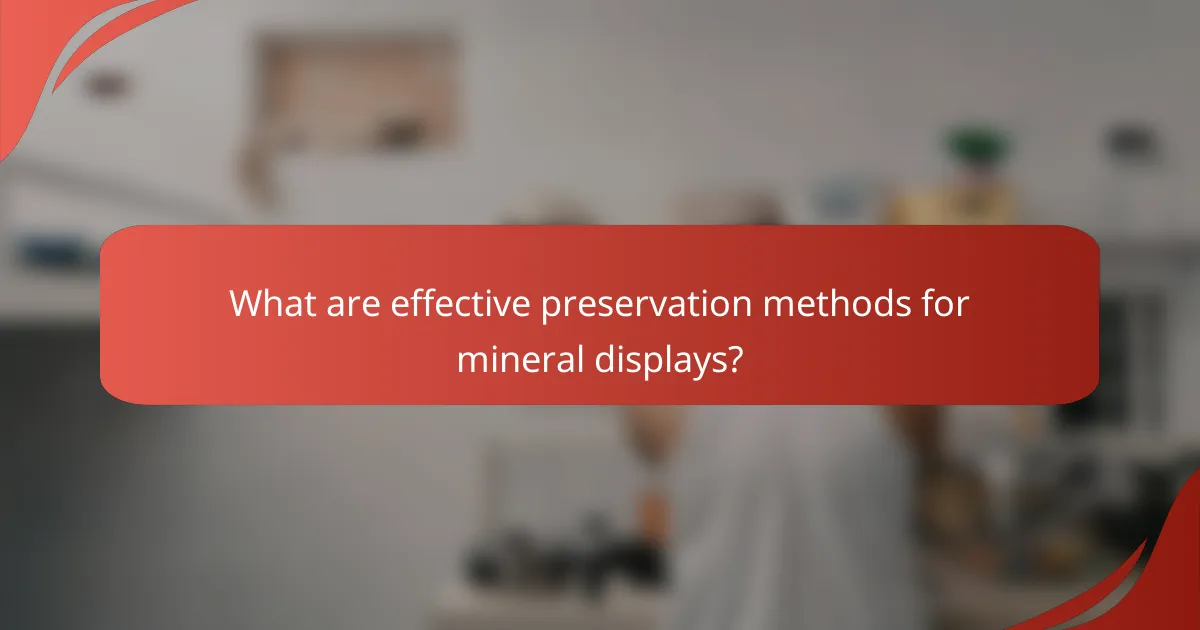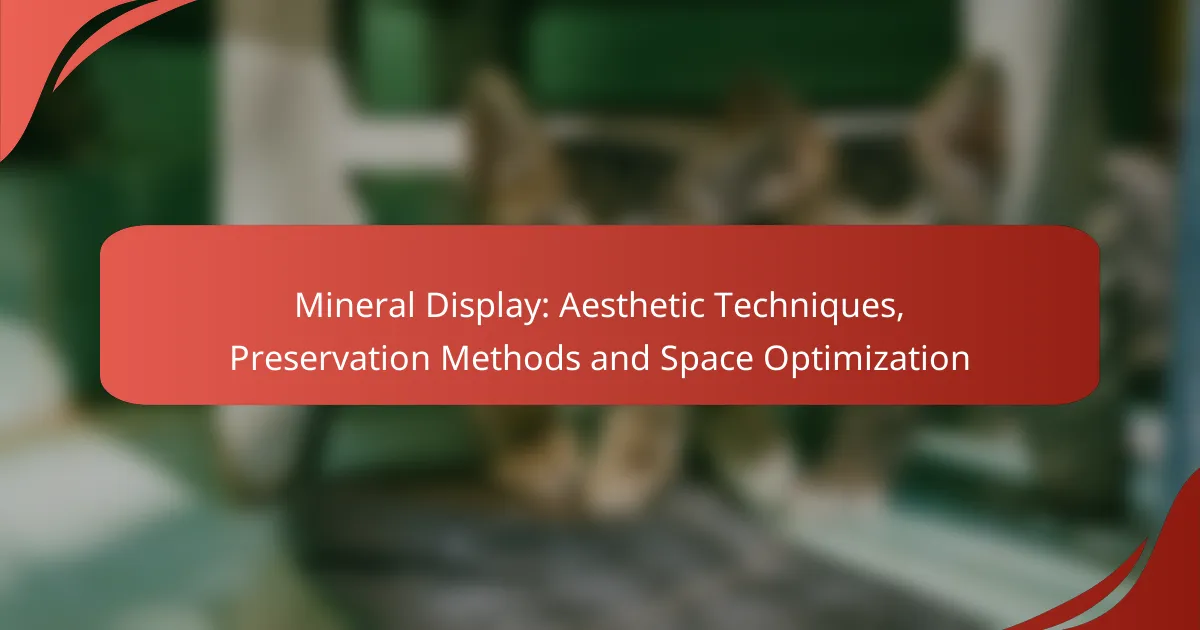Creating an engaging mineral display requires a careful balance of aesthetic techniques, preservation methods, and space optimization. By employing thoughtful design choices such as lighting and color, one can enhance visibility and visitor interaction. Additionally, maintaining optimal environmental conditions is crucial for preserving the integrity of the minerals, while strategic use of vertical space and adaptable furniture can maximize display areas in limited environments.

How to display minerals aesthetically in urban environments?
To display minerals aesthetically in urban environments, focus on maximizing visibility and engagement through thoughtful design choices. Consider factors like lighting, color, and materials to create an inviting and informative display that captures attention.
Use of natural light
Natural light enhances the visual appeal of minerals by highlighting their colors and textures. Position displays near windows or in well-lit areas to take advantage of sunlight, but be cautious of direct exposure, which can cause fading over time.
Using adjustable shades or diffusers can help manage light intensity, ensuring minerals are showcased beautifully without damage. Aim for a balance that allows for vibrant displays while protecting the integrity of the specimens.
Incorporating color contrasts
Color contrasts can significantly enhance the visual impact of mineral displays. Pair vibrant minerals with neutral backgrounds to make their colors pop, or use complementary colors to create a dynamic visual experience.
For example, a deep blue mineral displayed against a soft beige backdrop can create a striking effect. Experiment with different combinations to find what best highlights the unique features of each specimen.
Utilizing transparent display cases
Transparent display cases allow for unobstructed views of minerals while protecting them from dust and damage. Acrylic or glass cases can be effective, as they provide clarity and durability.
Ensure that the cases are well-lit from various angles to avoid shadows that can obscure details. Consider using cases with adjustable shelves to accommodate different sizes and shapes of minerals, optimizing the use of space.
Layering with complementary materials
Layering minerals with complementary materials can create depth and interest in displays. Use natural elements like wood, stone, or metal to enhance the overall aesthetic and provide context for the minerals.
For instance, a mineral specimen can be placed on a wooden base, surrounded by small pebbles or sand, mimicking its natural environment. This approach not only beautifies the display but also educates viewers about the mineral’s origin.
Creating themed displays
Themed displays can tell a story and engage viewers more effectively. Consider organizing minerals by geographic origin, color, or type, which can create a cohesive narrative that draws interest.
For example, a display featuring minerals from a specific region can include maps and information about the local geology, enhancing the educational aspect. Themes can also change seasonally or for special events, keeping the display fresh and inviting for repeat visitors.

What are effective preservation methods for mineral displays?
Effective preservation methods for mineral displays focus on maintaining optimal environmental conditions to prevent deterioration. Key strategies include controlling humidity, using UV-filtering display cases, implementing regular cleaning protocols, and regulating temperature.
Humidity control techniques
Maintaining appropriate humidity levels is crucial for preserving minerals, as excessive moisture can lead to mold growth and mineral degradation. Aim for a humidity range of 40-60% to ensure the longevity of your collection.
Using dehumidifiers or humidifiers can help achieve this balance. Regularly monitor humidity levels with hygrometers to avoid fluctuations that could harm your minerals.
UV-filtering display cases
UV light can cause fading and damage to minerals over time. Utilizing UV-filtering display cases is an effective method to protect your collection from harmful radiation. These cases are designed to block a significant percentage of UV rays while allowing visible light to illuminate the minerals.
When selecting a display case, look for materials specifically labeled as UV-filtering. This investment can significantly prolong the vibrancy and integrity of your minerals.
Regular cleaning protocols
Establishing a routine cleaning protocol is essential for maintaining mineral displays. Dust and debris can accumulate, leading to potential damage. Use a soft brush or microfiber cloth to gently remove dust without scratching the surfaces.
Clean your minerals every few months, but be cautious with water; some minerals are sensitive to moisture. Instead, consider using a dry cleaning method or a specialized mineral cleaning solution when necessary.
Temperature regulation strategies
Temperature fluctuations can adversely affect minerals, causing expansion and contraction that may lead to cracks. Aim to keep your display area within a stable temperature range of 18-22°C (64-72°F) for optimal preservation.
Utilizing climate control systems, such as air conditioning or heating, can help maintain this range. Additionally, avoid placing displays near heat sources or windows to minimize temperature variations.

How to optimize space for mineral displays in small galleries?
To optimize space for mineral displays in small galleries, focus on utilizing vertical space and selecting adaptable furniture. Effective organization and creative display techniques can enhance visibility while maintaining a clutter-free environment.
Vertical display solutions
Vertical display solutions maximize limited floor space by utilizing walls for showcasing minerals. Consider wall-mounted shelves, pegboards, or display cases that extend upwards rather than spreading outwards. This approach not only saves space but also draws the eye upward, creating an illusion of a larger area.
When implementing vertical displays, ensure that the weight capacity is suitable for the minerals being showcased. Use clear acrylic or glass cases to protect the specimens while allowing for unobstructed views.
Modular shelving systems
Modular shelving systems offer flexibility in arranging mineral displays according to available space. These systems can be reconfigured to fit different layouts, making them ideal for changing exhibitions or seasonal displays. Look for options that allow for adjustable heights and widths to accommodate various mineral sizes.
When selecting modular shelving, prioritize materials that are both durable and aesthetically pleasing, such as wood or metal. This ensures that the display not only serves its purpose but also enhances the overall gallery ambiance.
Multi-functional furniture
Multi-functional furniture can serve dual purposes, such as providing display space while also offering storage. Consider benches or tables with built-in compartments for storing additional minerals or display materials. This approach helps maintain an organized space while maximizing functionality.
Choose furniture that complements the gallery’s theme and is easy to move, allowing for quick rearrangements as needed. Ensure that any display surfaces are sturdy enough to support the weight of the minerals without compromising safety.
Incorporating digital displays
Incorporating digital displays can enhance the visitor experience while saving physical space. Digital screens can showcase high-resolution images of minerals, provide educational content, or even feature interactive elements. This allows galleries to present a wider range of information without overcrowding physical displays.
When integrating digital displays, consider the placement to ensure visibility from various angles. Use screens that are easy to update with new content, keeping the information fresh and engaging for repeat visitors.

What criteria should be considered when selecting display materials?
When selecting display materials for mineral collections, key criteria include durability, compatibility with different mineral types, and cost-effectiveness. These factors ensure that the display not only showcases the minerals effectively but also preserves their integrity over time.
Durability and longevity
Durability is crucial for display materials, as they must withstand environmental factors such as humidity and temperature fluctuations. Materials like acrylic or tempered glass are often preferred due to their resistance to breakage and fading.
Choosing materials that are UV-resistant can further enhance longevity by preventing discoloration of the minerals. Regular maintenance and cleaning can also extend the life of the display materials.
Compatibility with mineral types
Different minerals have varying sensitivities to environmental conditions, so it’s essential to select display materials that are compatible with the specific types of minerals being showcased. For example, some minerals may react negatively to certain plastics or metals.
Using inert materials, such as glass or specific types of wood, can help prevent chemical reactions that might damage the minerals. It’s advisable to research the specific needs of each mineral before finalizing display choices.
Cost-effectiveness
Cost-effectiveness is a significant consideration when selecting display materials. While high-quality materials may require a larger initial investment, they can save money in the long run by reducing the need for replacements due to wear and tear.
Consider balancing quality with budget constraints by exploring options like bulk purchasing or alternative materials that offer similar durability at a lower cost. Always evaluate the total cost of ownership, including maintenance and replacement, when making decisions.

What are the best practices for lighting mineral displays?
Effective lighting is crucial for showcasing mineral displays, enhancing their colors and textures while minimizing damage. The best practices involve using appropriate light sources, positioning, and intensity to highlight the unique features of each specimen.
Types of lighting
When lighting mineral displays, consider using LED lights, which emit minimal heat and UV radiation, reducing the risk of damage to the specimens. Fluorescent lights can also be effective, but they may produce more heat and require careful placement to avoid fading colors over time.
Natural light can enhance the beauty of minerals, but it should be used cautiously. Direct sunlight can cause fading and deterioration, so using diffused or indirect natural light is preferable.
Light positioning
Positioning lights at various angles can create depth and dimension in your mineral display. Side lighting can emphasize textures, while overhead lighting can provide an even illumination. Experimenting with different angles will help you find the most flattering setup for your collection.
Using multiple light sources can also help eliminate shadows and highlight different aspects of the minerals. Consider placing lights at both low and high angles to achieve a balanced effect.
Intensity and color temperature
The intensity of light should be adjustable to prevent overwhelming the minerals. A good rule of thumb is to start with lower intensity and gradually increase it until the desired effect is achieved. Aim for a brightness that enhances the display without causing glare.
Color temperature plays a significant role in how minerals are perceived. Warmer light (around 2700K to 3000K) can enhance the richness of colors, while cooler light (5000K to 6500K) can provide a more natural appearance. Choose a color temperature that complements the specific minerals in your display.
